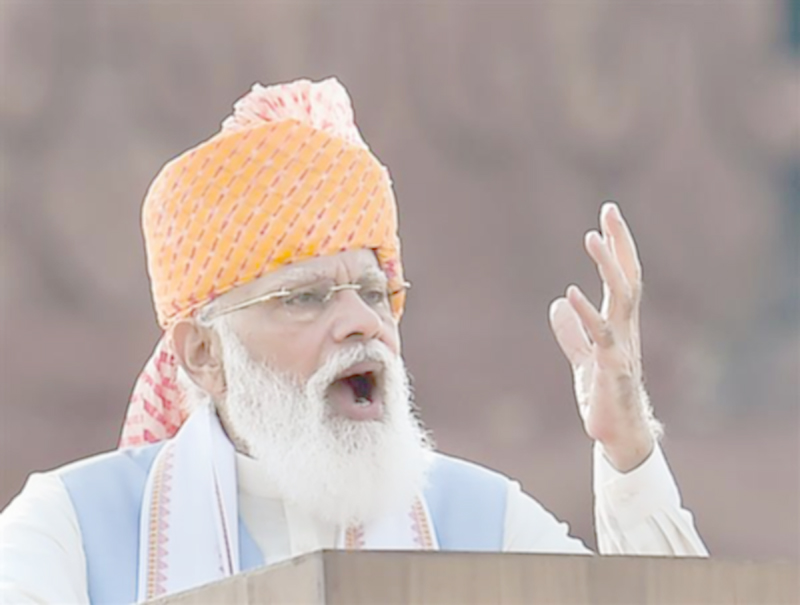Modi going to inspect a Guard of Honour presented by the Bhutanese Army in Thimpu
By Bharat Karnad
“Who will not want a friend and a neighbour like Bhutan?” an elated Prime Minister Narendra Modi asked rhetorically, after wrapping up his visit to Thimpu, August 19, 2019. “The two countries are living the definition of true friendship.” He had just concluded a warm, friendly, and successful visit during which 10 Memoranda of Understanding were signed in several fields ranging from space, aviation Information Technology, power and education.
Modi also inaugurated the Rs. 4,500 crore, 720MW, Mangdechhu hydroelectric power plant in central Bhutan, one of a series of power projects India has helped finance and build over the years to harness that country’s rivers to the tune of 10,000 MW a milestone reached last year. It is electricity an energy starved India buys back at remunerative prices in a virtuous cycle of joint Indo-Bhutanese planning, Indian investment and construction, and goodly economic returns for both parties.
Two short years later, it was the turn of Beijing on Oct 14, 2021 to crow that the “deadlock” had been broken in the talks begun in 1984 with Bhutan to settle the border, and that the latest (24th) virtual round of characteristically interminable negotiations (a tactic the Chinese use to break the opposing side’s patience and resolve), had resulted in Thimpu agreeing to a three step process for final demarcation of the disputed Sino-Bhutanese border, and the establishment of formal diplomatic ties.
Soon India will no more have Bhutan to itself. With a doubtless big, fully manned, Chinese embassy in Thimpu contesting the diplomatic space with India, the Chinese will overwhelm the Bhutanese with offers of infrastructure projects and easy credit to built them and, perhaps, a Chinese military training scheme and transfer of armaments to compete with IMTRAT (Indian Military Training Team). Bhutan too will begin doing what other South Asian states Sri Lanka, Bangladesh, Nepal and Maldives, have learned to do do profitably play New Delhi off against Beijing. That’s the least of the problems though.
What’s really worrisome is that MEA had no inkling about this development, was caught unawares and was surprised by this breakthrough coming down the pike. For Bhutan, an Indian protectorate in all but name, to keep such an important decision one to cut a deal with Beijing a secret, suggests Thimpu may be willing to agree to an exchange the Chinese had proposed in 1997:
Beijing giving up its claims in central Bhutan for territory in western Bhutan that includes the Doklam trijunction with India. Except, per an earlier three way agreement, any decision on Doklam has to be in consultation with India. It will be interesting to see how Thimpu and Beijing manage this, assuming MEA doesn’t just lay down as is its habit and let the Chinese run a steamroller over its diplomats.
Doklam is where Chinese ingress by way of road building southwestwards towards the Siliguri corridor the “chicken’s neck”, had almost sparked hostilities in June 2017. Some 270 Sikkim-based Indian troops alongside two bulldozers had then stopped the Chinese road construction. That standoff did not, however, result in a PLA withdrawal from that area and the Chinese completed the road.
Then in mid-2020, while India was preoccupied with the Chinese transgressions in eastern Ladakh, Beijing laid claim to the Sakteng wildlife sanctuary in eastern Bhutan. In response, India proposed constructing a road through the Yeti region of Bhutan to Tawang, cutting the distance to Guwahati by 150 kms to enable faster shifting of land forces in an emergency. It is not known whether there’s progress, if any, in this project. And this is where matters stand today.
The historic pattern is that India always reacts and reacts some more, never ever taking the initiative at any time for anything in terms of aggressively occupying contested land, especially where China is concerned. It seems fearful of the inevitable Chinese response, which it apprehends the Indian military will not be able to deal with. The Indian army is silently complicit in this arrangement because it doesn’t if it can help it want to tangle with the PLA handing it, in the process, the psychological edge. Signalling in any way reluctance to engage in military action is tantamount to ceding ground.
How one wishes for a dashing General Sagat Singh to emerge from somewhere, take charge, and get a fist up PLA’s nose, as he did as GOC, 17 Division, at Nathu la in 1967. Meanwhile, with Bhutan in the bag China has about finished its grand geostrategic design of encircling India, and confining it to its sub-continental strategic coffin. Circlement and counter-encirclement are at the core and the very essence of Chinese military maneuvering and strategy. It is something the strategically dim-witted Indian government has historically been unable for some incomprehensible reason to even envision, let alone practice.
So, while India’s neighbourhood is now palpably under Chinese control with Pakistan posing as Beijing’s stalking horse, the Chinese periphery is terra incognita and, owing to Indian diplomatic and military passivity, is getting beyond India’s political-military reach. In this respect consider the heavy weather the Indian government has made over the last 20 years of merely transferring Brahmos cruise missiles to Vietnam when this should have been A-1 priority. Indulging periodically in Malabar naval exercises with the US and other navies in the seas WEST of the Malacca Straits is not going to cut it.
Ah, yes, but as I have always reassuringly reminded everybody, there’s fortunately Pakistan to berate and beat up on, and threaten more Balakots with no matter that the original Balakot aerial excursion, as I had mentioned in a post soon after that “operation”, was a bad joke, a non-event. Pakistan, I suspect Home Minister Amit Shahji please note would welcome your verbal “sturm und drang” topped with such harmless military Indian actions!


